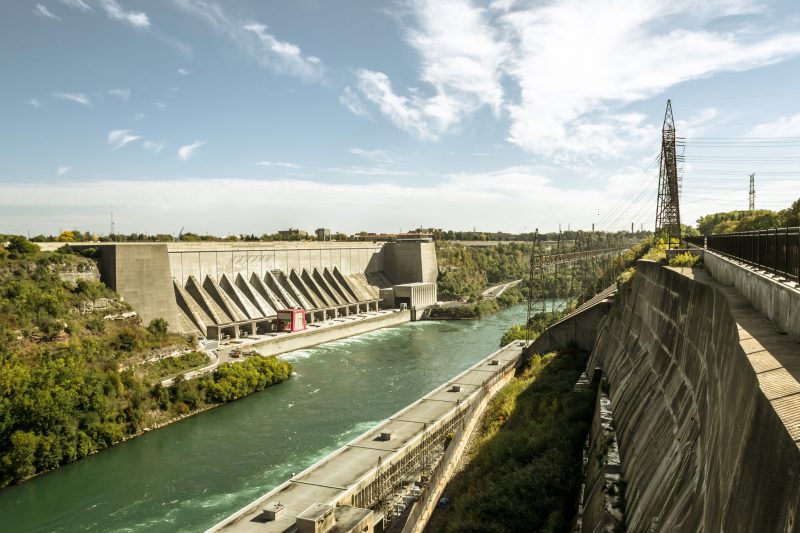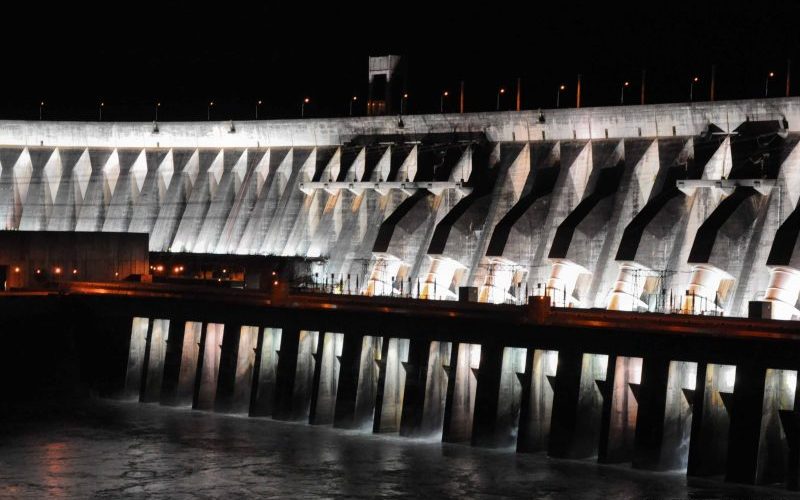The hydroelectric power is that generated by the action of the movement of water, usually in falls (geodesic jumps) and slopes or specialized dams, where power plants are installed to take advantage of the mechanical energy of the moving liquid and activate the generator turbines that produce electricity. For example: Niagara Falls, Xilodu Dam, Salime Reservoir.
This method of use of water provides a fifth of electrical energy worldwide, and it is not exactly new in human history: the ancient Greeks, following the same and exact principle, ground wheat to make flour using the force of water or wind with a series of mills . However, the first hydroelectric plant as such was built in 1879 in the United States.
This type of power plants They are popular in rugged geographies whose waters, product of the thaw at the top of the mountains or the interruption of the course of some mighty river, accumulate a considerable amount of force. Other times it is necessary to build a dam to control the release and storage of water and thus artificially propitiate a fall of the desired magnitudes.
The power This type of power plant can vary, from large and powerful power plants that generate tens of thousands of megawatts, to the so-called mini-hydro power plants that generate just a few megawatts.
Types of hydroelectric plants
According to their architectural conception, a distinction is usually made between open-air hydroelectric plants, such as those installed at the foot of a waterfall or a dam, and cavern hydroelectric plants, those far from the water source but connected to it by pressure pipes and other types of tunnels.
These plants can also be classified according to the flow of water in each case, namely:
- Flowing water plants. They operate continuously, taking advantage of the water of a river or a fall, as they do not have the capacity to store water as in reservoirs.
- Reservoir plants. They retain the water by means of a dam and allow it to flow through the turbines, maintaining a constant and controllable flow. They are much more expensive than flowing water.
- Centrals with regulation. Installed in rivers, but with the capacity to store water.
- Pumping stations. They combine the generation of electricity by the flow of water with the ability to send the liquid back up, perpetuating the cycle and functioning as gigantic batteries.
Advantages of hydroelectric power
Hydroelectric energy was very much in vogue during the second half of the 20th century, given its unquestionable virtues, which are:
- Cleaning. Compared to burning fossil fuels, it is a low-polluting energy.
- Security. Compared to the potential disasters of nuclear power or other risky forms of electricity generation, its risks are manageable.
- Constancy. River water supplies and large falls are usually fairly constant throughout the year, ensuring the regular operation of the generating plant.
- Economy. As it does not require raw materials or complicated processes, it is an inexpensive and simple electricity generation model, which lowers the costs of the entire energy production and consumption chain.
- Autonomy. As it does not require raw materials or supplies (beyond eventual spare parts), it is a model that is quite independent from market fluctuations and international treaties or political provisions.
Disadvantages of hydropower
- Local incidence. The construction of dams and dikes, as well as the installation of turbines and generators has an impact on the course of rivers that often affects local ecosystems.
- Eventual risk. Although rare and avoidable with a good maintenance routine, it is possible for a break in a levee to cause the uncontrolled release of more than manageable water volume, leading to flooding and local catastrophes.
- Landscape impact. Most of these facilities radically alter natural landscapes and have an impact on the local landscape, although they can also become tourist reference points.
- Deterioration of the riverbeds. The continuous intervention on the flow of water erodes the river beds and alters the nature of the water, subtracting sediments. This all has a river impact to consider.
- Possible droughts. In cases of extreme drought, these generation models see their production limited, since the volume of water is less than ideal. This can mean energy cuts or rate increases, depending on the extent of the drought.
Examples of hydropower

- Niagara Falls. The hydroelectric power station Robert Moses Niagara Power Plant Located in the United States, it was the first hydroelectric plant in history to be built, taking advantage of the power of the enormous Niagara Falls in Appleton, Wisconsin.
- Krasnoyarsk hydroelectric dam. A 124 m high concrete dam located on the Yenisei River in Divnogorsk, Russia, built between 1956 and 1972 and providing around 6000 MW of energy to the Russian people. The Krasnoyarkoye reservoir was created for its operation.
- Salime Reservoir. This Spanish reservoir located in Asturias, on the Navia riverbed, was inaugurated in 1955 and provides the population with around 350 GWh per year. To build it, the riverbed had to be changed forever and nearly 2,000 farms flooded on 685 hectares of arable land, along with urban farms, bridges, cemeteries, chapels and churches.
- Guavio hydroelectric plant. The second largest power plant in operation in Colombia, it is located in Cundinamarca, 120km from Bogotá and generates about 1,213 MW of electricity. It came into operation in 1992, despite the fact that three additional units have yet to be installed for financial reasons. If it does, the performance of this reservoir would increase to 1,900 MW, the highest in the entire country.
- Simón Bolívar hydroelectric plant. Also called Presa del Guri, it is located in Bolívar state, Venezuela, at the mouth of the Caroni River in the famous Orinoco River. It has an artificial reservoir called Embalse del Guri, with which electricity is supplied to a good part of the country and is even sold to the border towns of northern Brazil. It was completely inaugurated in 1986 and is the fourth largest hydroelectric plant in the world, offering 10,235 MW of total installed capacity in 10 different units.
- Xilodu dam. Located on the Jinsha River in southern China, it has an installed capacity of 13,860 MW of electricity, in addition to allowing control of the flow of water to facilitate navigation and prevent flooding. It is currently the third largest hydroelectric power station in the world and also the fourth tallest dam on the planet.
- Three Gorges Dam. Also located in China, on the Yangtze River in the center of its territory, it is the largest hydroelectric plant in the world, with a total power of 24,000 MW. It was completed in 2012, after flooding 19 cities and 22 towns (630 kmtwo surface), with which almost 2 million people had to be evacuated and relocated. With its 2309 meter long and 185 high dam, this power plant alone provides 3% of the colossal energy consumption in this country.
- Yacyretá-Apipé Dam. This dam located in a joint Argentine-Paraguayan zone on the Paraná River, supplies almost 22% of Argentina’s energy demand with its 3,100 MW of power. It was an extremely controversial construction, as it required the flooding of unique habitats in the region and the extinction of dozens of endemic species of animals and plants.
- Palomino Hydroelectric Project. This project under construction in the Dominican Republic will be located on the Yaraque-Sur and Blanco rivers, where a reservoir with a total area of 22 hectares will be located and which will increase the country’s energy generation by 15%.
- Itaipu Dam. The second largest hydroelectric plant in the world, it is a binational project between Brazil and Paraguay to take advantage of their border on the Paraná River. The artificial length of the dam covers about 29,000 hm3 of water in an area of approximately 14,000 kmtwo. Its generation capacity is 14,000 MW and it began production in 1984.

Other types of energy
| Potential energy | Mechanical energy | Kinetic energy |
| Hydroelectric power | Internal energy | Caloric energy |
| Electric power | Thermal energy | Geothermal energy |
| Chemical energy | Solar energy | Sound energy |
| Wind power | Nuclear energy | Hydraulic energy |
